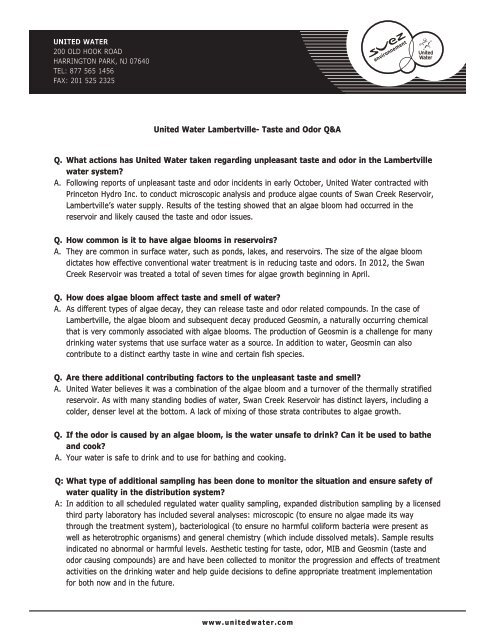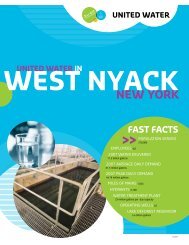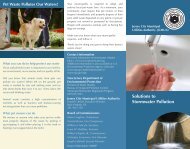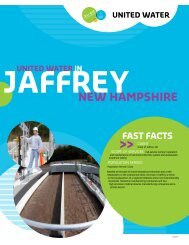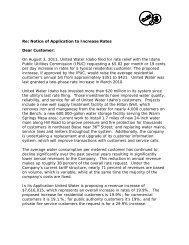United Water Lambertville Taste and Odor Q and A
United Water Lambertville Taste and Odor Q and A
United Water Lambertville Taste and Odor Q and A
You also want an ePaper? Increase the reach of your titles
YUMPU automatically turns print PDFs into web optimized ePapers that Google loves.
<strong>United</strong> <strong>Water</strong><br />
200 OLD HOOK ROAD<br />
HARRINGTON PARK, NJ 07640<br />
TEL: 877 565 1456<br />
FAX: 201 525 2325<br />
<strong>United</strong> <strong>Water</strong> <strong>Lambertville</strong>- <strong>Taste</strong> <strong>and</strong> <strong>Odor</strong> Q&A<br />
Q. What actions has <strong>United</strong> <strong>Water</strong> taken regarding unpleasant taste <strong>and</strong> odor in the <strong>Lambertville</strong><br />
water system?<br />
A. Following reports of unpleasant taste <strong>and</strong> odor incidents in early October, <strong>United</strong> <strong>Water</strong> contracted with<br />
Princeton Hydro Inc. to conduct microscopic analysis <strong>and</strong> produce algae counts of Swan Creek Reservoir,<br />
<strong>Lambertville</strong>’s water supply. Results of the testing showed that an algae bloom had occurred in the<br />
reservoir <strong>and</strong> likely caused the taste <strong>and</strong> odor issues.<br />
Q. How common is it to have algae blooms in reservoirs?<br />
A. They are common in surface water, such as ponds, lakes, <strong>and</strong> reservoirs. The size of the algae bloom<br />
dictates how effective conventional water treatment is in reducing taste <strong>and</strong> odors. In 2012, the Swan<br />
Creek Reservoir was treated a total of seven times for algae growth beginning in April.<br />
Q. How does algae bloom affect taste <strong>and</strong> smell of water?<br />
A. As different types of algae decay, they can release taste <strong>and</strong> odor related compounds. In the case of<br />
<strong>Lambertville</strong>, the algae bloom <strong>and</strong> subsequent decay produced Geosmin, a naturally occurring chemical<br />
that is very commonly associated with algae blooms. The production of Geosmin is a challenge for many<br />
drinking water systems that use surface water as a source. In addition to water, Geosmin can also<br />
contribute to a distinct earthy taste in wine <strong>and</strong> certain fish species.<br />
Q. Are there additional contributing factors to the unpleasant taste <strong>and</strong> smell?<br />
A. <strong>United</strong> <strong>Water</strong> believes it was a combination of the algae bloom <strong>and</strong> a turnover of the thermally stratified<br />
reservoir. As with many st<strong>and</strong>ing bodies of water, Swan Creek Reservoir has distinct layers, including a<br />
colder, denser level at the bottom. A lack of mixing of those strata contributes to algae growth.<br />
Q. If the odor is caused by an algae bloom, is the water unsafe to drink? Can it be used to bathe<br />
<strong>and</strong> cook?<br />
A. Your water is safe to drink <strong>and</strong> to use for bathing <strong>and</strong> cooking.<br />
Q: What type of additional sampling has been done to monitor the situation <strong>and</strong> ensure safety of<br />
water quality in the distribution system?<br />
A: In addition to all scheduled regulated water quality sampling, exp<strong>and</strong>ed distribution sampling by a licensed<br />
third party laboratory has included several analyses: microscopic (to ensure no algae made its way<br />
through the treatment system), bacteriological (to ensure no harmful coliform bacteria were present as<br />
well as heterotrophic organisms) <strong>and</strong> general chemistry (which include dissolved metals). Sample results<br />
indicated no abnormal or harmful levels. Aesthetic testing for taste, odor, MIB <strong>and</strong> Geosmin (taste <strong>and</strong><br />
odor causing compounds) are <strong>and</strong> have been collected to monitor the progression <strong>and</strong> effects of treatment<br />
activities on the drinking water <strong>and</strong> help guide decisions to define appropriate treatment implementation<br />
for both now <strong>and</strong> in the future.<br />
www.unitedwater.com
Q. How long does it take for treatments to work?<br />
A. That depends on many factors, including the size of the bloom. In the case of <strong>Lambertville</strong>, microscopic<br />
analysis of reservoir samples one week after treatment showed that the algae in question had been<br />
largely eliminated <strong>and</strong> the musty taste <strong>and</strong> odor was reduced but still apparent due to the by-products of<br />
the algae bloom.<br />
Q. What is <strong>United</strong> <strong>Water</strong> doing now to address the taste <strong>and</strong> odor of the water?<br />
A. In October, an exp<strong>and</strong>ed distribution sampling program was initiated for various locations in our<br />
system. Additional tests were conducted for taste <strong>and</strong> odor, algae, general water quality <strong>and</strong> secondary<br />
parameters.<br />
Though we are out of the active algae growing season <strong>and</strong> the musty taste <strong>and</strong> odor has been largely<br />
reduced, the extent of the bloom has left a residual impact to the reservoir that has changed the<br />
characteristics of the source water <strong>and</strong> will require installation of additional equipment to treat both the<br />
reservoir <strong>and</strong> in the treatment facility. These changes take time to develop the correct approach so that<br />
there are not unintended consequences on other treatment mechanisms. It also takes some time to<br />
procure, install <strong>and</strong> test the new equipment <strong>and</strong> treatment processes.<br />
In mid-January powdered activated carbon (PAC) will be applied to water in the treatment plant. PAC is<br />
approved by the NJ Department of Environmental Protection (NJDEP) as a treatment method for taste <strong>and</strong><br />
odor control, <strong>and</strong> is used successfully at other <strong>United</strong> <strong>Water</strong> facilities for seasonal taste <strong>and</strong> odor control<br />
concerns.<br />
Q. What is <strong>United</strong> <strong>Water</strong> doing to address problems related to future algae blooms in<br />
Swan Creek Reservoir?<br />
A. While these odor events can be difficult to predict <strong>and</strong> avoid, <strong>United</strong> <strong>Water</strong> is taking additional preparatory<br />
steps. These steps include earlier <strong>and</strong> more frequent profile testing of the reservoir to look for the specific<br />
taste <strong>and</strong> odor compounds; <strong>and</strong> how they relate to algal counts. To control algae blooms, <strong>United</strong> <strong>Water</strong><br />
will continue to apply small amounts of copper sulfate to the reservoir, adhering to strict federal <strong>and</strong> state<br />
environmental protection guidelines outlined in <strong>United</strong> <strong>Water</strong>’s NJDEP-issued treatment permit.<br />
Also, <strong>United</strong> <strong>Water</strong> is in the process of installing an enhanced aeration system in the reservoir to both<br />
aerate water <strong>and</strong> mix the distinct layers of water to create an environment that inhibits large algae<br />
blooms from forming in the future.


